Distinctive Collections
Friend Collection Hertzog Highlights
Open gallery
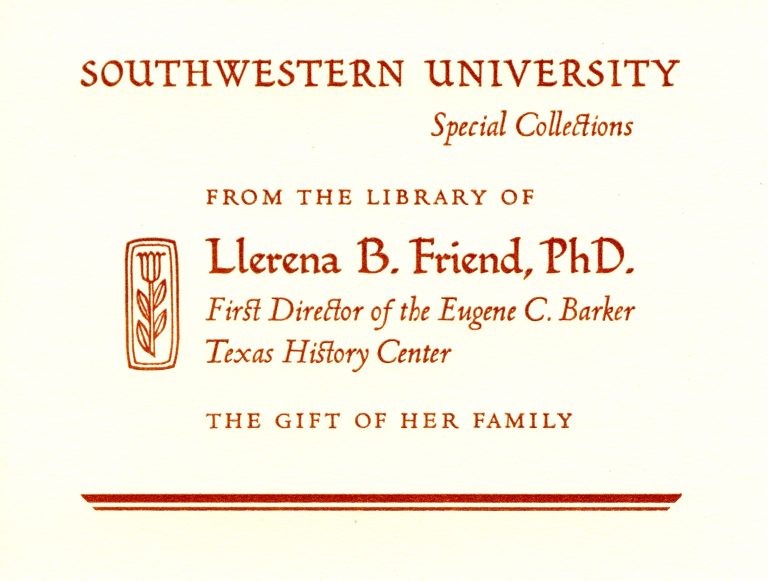
This is the first of four posts highlighting especially notable material from the Llerena B. Friend collection – and the first post is focused on the most significant items from Friend’s collection of Carl Hertzog.
I will freely admit to this being the hardest of these four highlight posts to do – there is just so much Hertzog material in the collection. A rough count tells us that over 100 of the items in her collection are printed by Hertzog, but these five items are the best of those Hertzog items.
The Texas Surgical Society; the First Fifty Years, 1965.
This book, while lovely, is not especially unusual to see, especially in Hertzog collections. The book was printed in 1050 copies, with a now-famous illustration by Tom Lea of Cabeza de Vaca performing the first recorded surgery in North America. What makes this copy stand out is the note from Hertzog to Friend tucked into the book, and reproduced here:
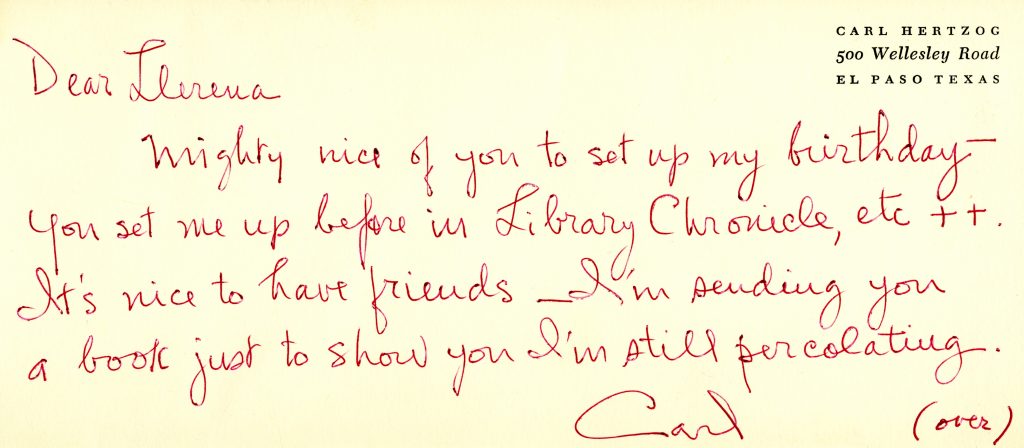
Dear Llerena
Mighty nice of you to set up my birthday – you set me up before in Library Chronicle, etc. ++. It’s nice to have friends – I’m sending you a book just to show you I’m still percolating.
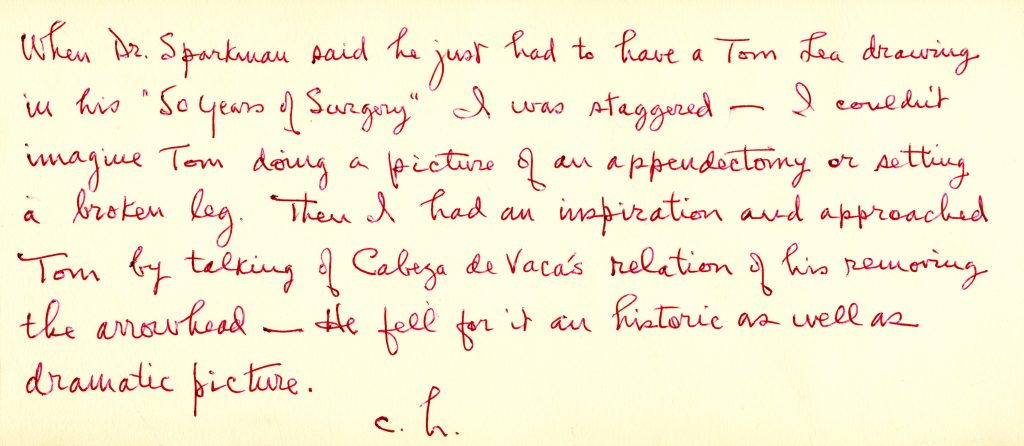
When Dr. Sparkman said he just had to have a Tom Lea drawing in his “50 Years of Surgery” I was staggered – I couldn’t imagine Tom doing a picture of an appendectomy or setting a broken leg. Then I had an inspiration and approached Tom by talking of Cabeza de Vaca’s relation of his removing the arrowhead – He fell for it and historic as well as dramatic picture.
c.h.
This note tells of how Lea was induced to make the now famous drawing of Cabeza de Vaca performing the first recorded surgery in North America, retold in his Relación. It is this note, which Friend kept with the book, that makes this copy supremely significant.
Calendar of Twelve Travelers Through the Pass of the North, 1947.
We hold a copy of the much more famous, and limited, 1946 printing of this title, but like some of the other books highlighted in this post, our copy of the reduced 1947 printing (in an edition of 25,000[!] copies) is notable thanks to the envelope it came to Friend in, from Hertzog himself. On the envelope he discusses why the reduced format was created.
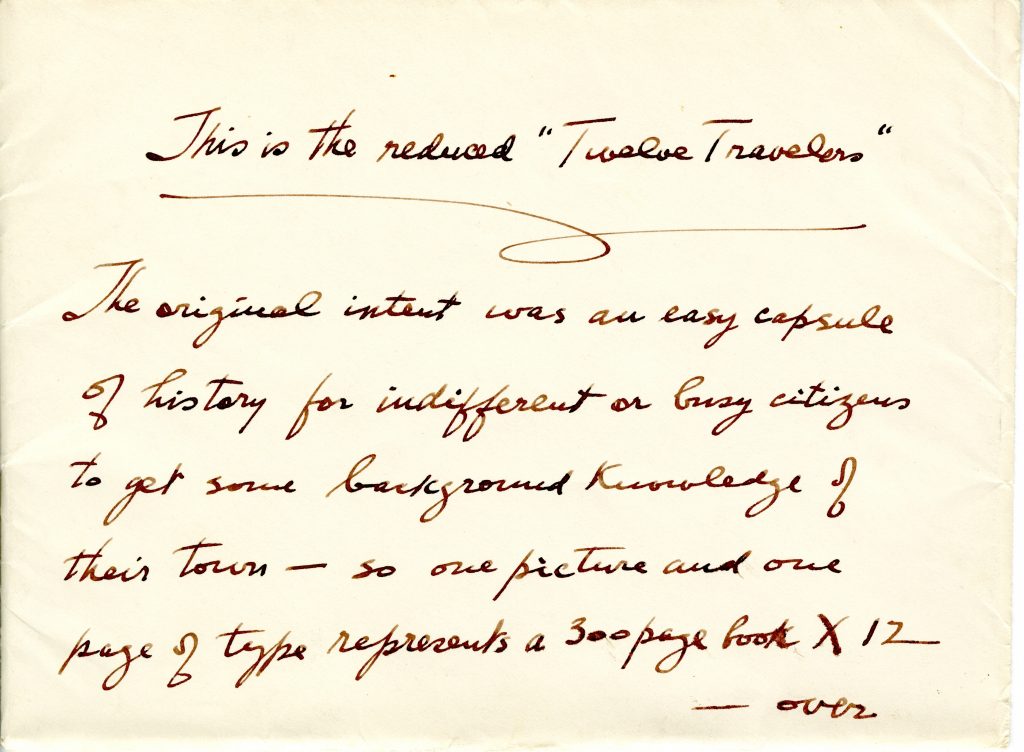
This is the reduced “Twelve Travelers”
The original intent was an easy capsule
of history for indifferent or busy citizens
to get some background knowledge of
their town – so one picture and one
page of type represents a 300 page book X 12
-over
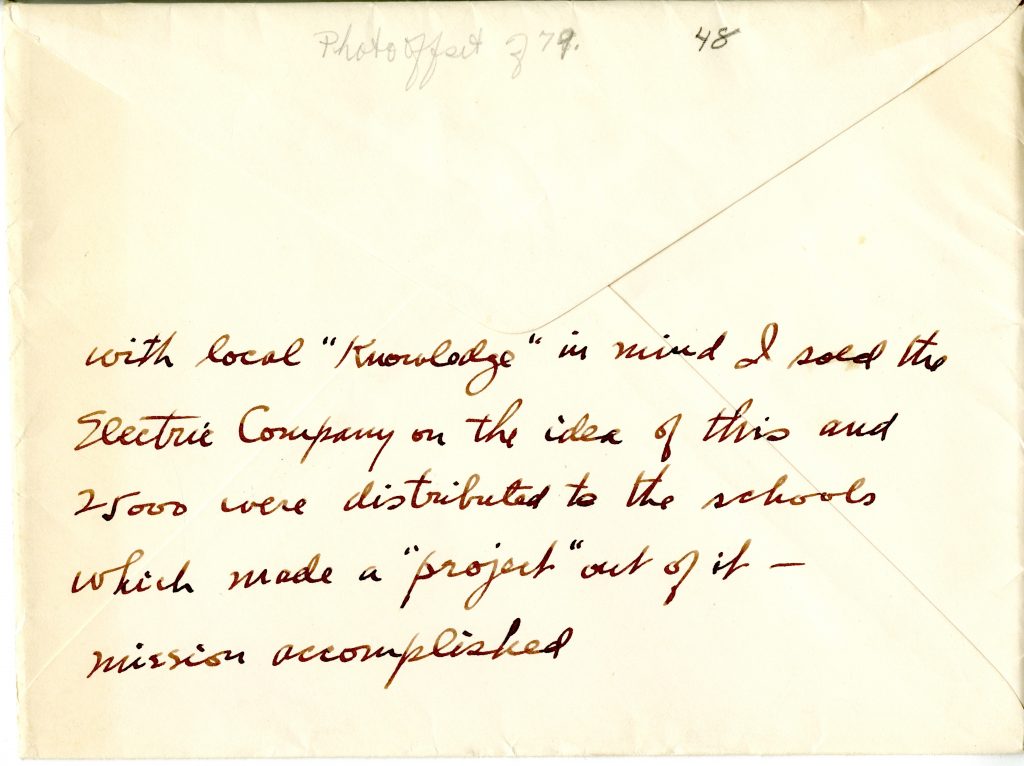
with local “knowledge” in mind I sold the
Electric Company on the idea of this and
25000 were distributed to the schools
which made a “project” out of it –
mission accomplished
Lowman recounts much the same story in his Printer at the Pass (note the number, 48, in Friend’s hand). Our copy is better described as 48b, as the Calendar in the envelope is in pictorial paper wrappers.
Bullfight Manual for Spectators, 1949.
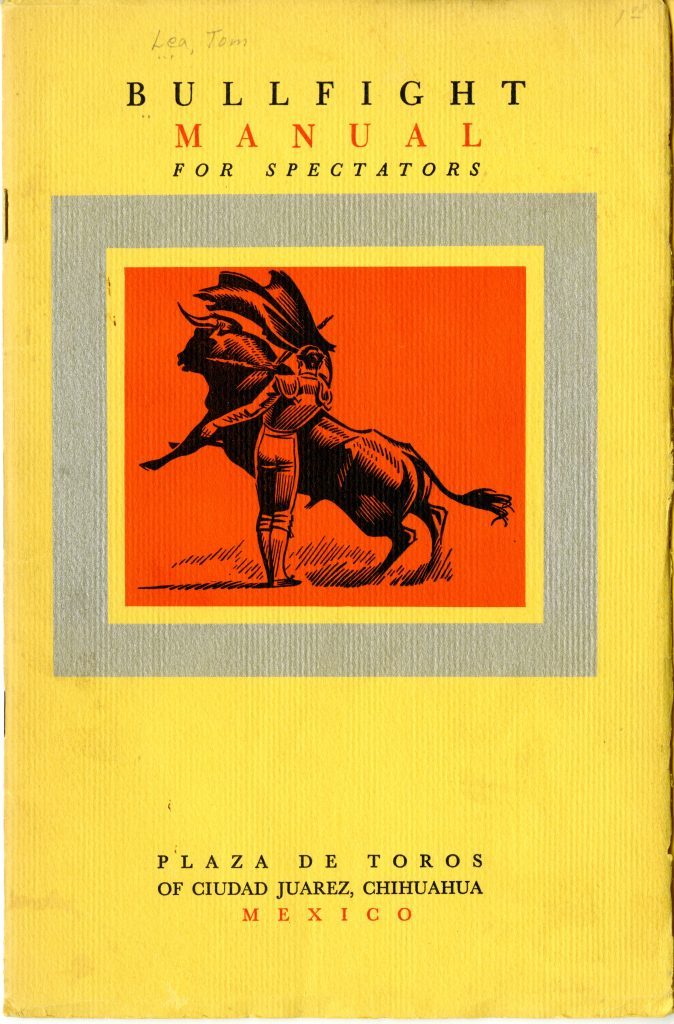
There is some confusion about the bibliographical history of the printing of this staple-bound item. Lowman asserts that the Juarez imprint is the first, with the true first being that imprint with smooth covers and trimmed edges.
However, in Dorothy Sloan’s catalog of The Library and Work of Carl Hertzog, Printer at the Pass, she casts more light on this subject – specifically that the “early” issues of the first edition are printed (as Friend’s copy is) with “manual” in red on the front cover, foreword beginning on p. 1, and with Tom Lea’s name in type on that same page. Sloan also states that though first edition first issues of this title are in smooth and trimmed wrappers, but later issues of the first are in textured, untrimmed wrappers (as ours is).
We now have 6 copies of the Juarez and El Paso imprints of this item, thanks to Friend and F. Warren Roberts – and my hope is that these copies will help untangle the printing mystery of this – about which Lowman wrote: “No item in the Hertzog inventory has generated more confusion than the proper identification of the true first edition of Bullfight Manual… To enumerate and describe the various editions of this work – published at El Paso, Juárez, San Marino, California, and elsewhere – would furnish ample material for another catalog.”
Tales of the Tularosa, 1963.
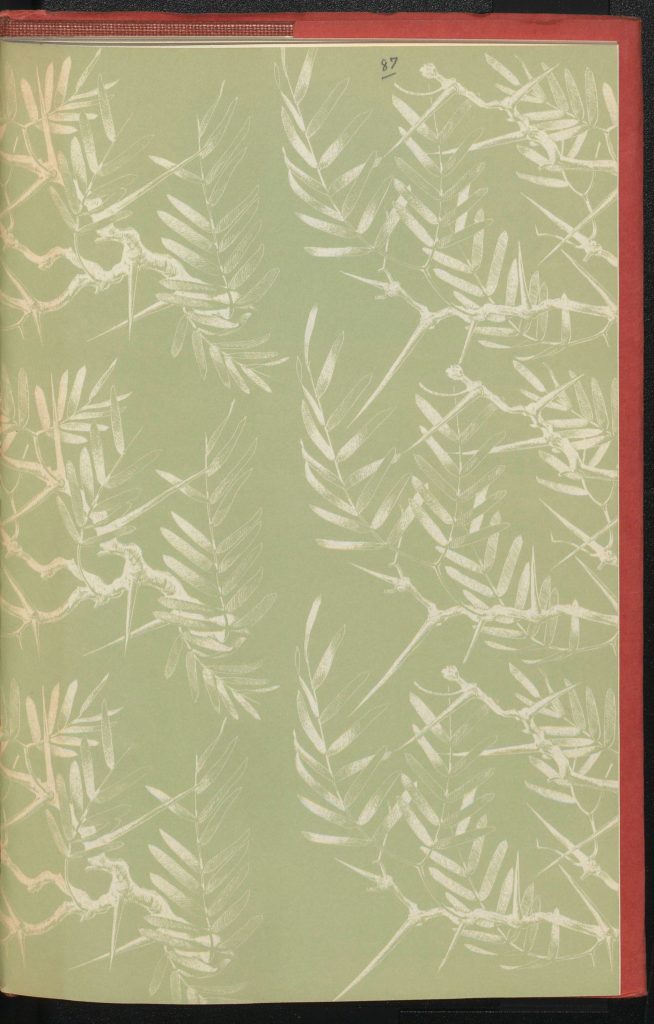
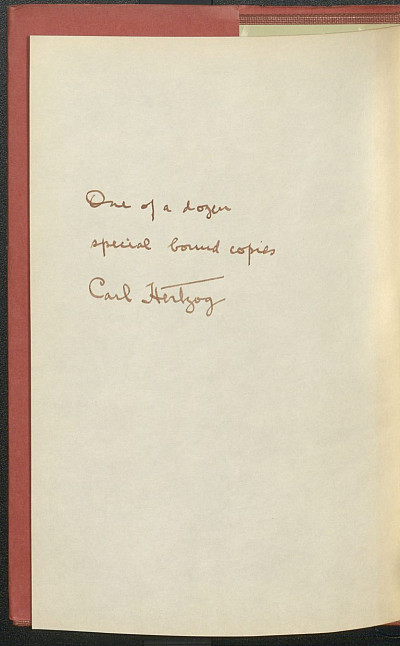
|
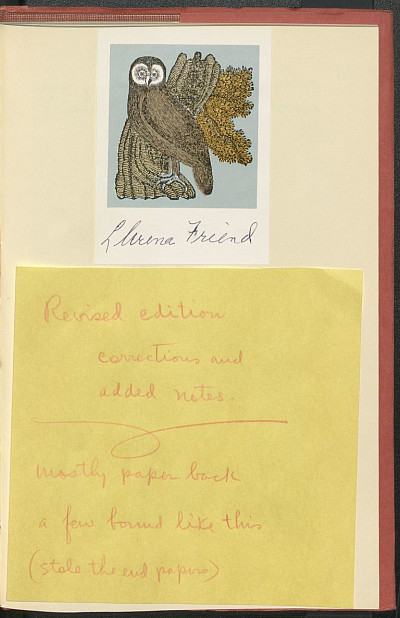
|
This book also went through several printings, and is not especially uncommon on its own. Thankfully, we have some notes in Hertzog’s hand that tell us the edition, and the rarity of this particular copy.
Before I proceed into the edition and binding – I want you to scroll up and look at the endpapers, and note that there is a small number in pencil on the front free endpaper – in Llerena Friend’s hand. You likely remember that Friend was a librarian by profession – and that is reflected in one of these numbers in each Hertzog volume in her collection. They are numbers from Al Lowman’s bibliography of Hertzog’s work, Printer at the Pass. This, then, is number 87 in that book – but it is also notnumber 87, due to the almost unique binding.
Especially unusual are those printed endpapers. Do they look familiar to you? They are the endpapers from Hertzog and Lea’s The King Ranch, which (according to his note) Hertzog “stole” a few of for this binding of Tales of the Tularosa. Indeed, he notes that this was one of a few copies “bound like this,” and that it was one of a dozen special-bound copies – not because of the cloth binding, but because of the endpapers. This binding is not recorded in Lowman’s bibliography, and seems to be unique in Hertzog collections.














